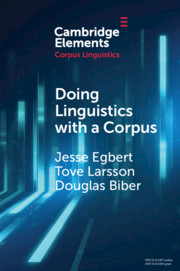Element contents
Doing Linguistics with a Corpus
Published online by Cambridge University Press: 13 October 2020
Summary
Keywords
Information
- Type
- Element
- Information
- Series: Elements in Corpus LinguisticsOnline ISBN: 9781108888790Publisher: Cambridge University PressPrint publication: 12 November 2020
References
Accessibility standard: Unknown
Why this information is here
This section outlines the accessibility features of this content - including support for screen readers, full keyboard navigation and high-contrast display options. This may not be relevant for you.Accessibility Information
- 75
- Cited by
